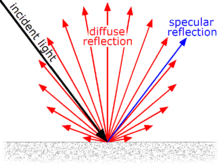Image formation - reflection
If we give each object in a program its own light intensity then we can write this as
I = ki
where I is the intensity of the observed light, and ki is the ith object's intrinsic emission intensity.
This is not going to produce very realistic graphics. Each each object wiould have an independent uniform colour. We could not make out any detail - only its silhouette. This could also lead to an unrealistic discrepancy in light intensity of neighbouring objects.

A better idea is to have all objects react to a common light source. This is what happens in reality. The light source bathes the object in light, some of that light is reflected or scattered and that is what enters the eye.
The observed light intensity (the light that goes into the eye) is therefore a function of:
- the light source's intensity
- the object's reflective properties (texture and colour - these will affect how much of the light is reflected)
The diagram below shows how the object's properties can affect how we percieve its colour.

There are three types of reflected light that we need to consider when making graphic images.
Ambient
Ia = Laka where
La is the intensity of the ambient light
ka is the object's ambient reflection coefficient. |
Ambient light is diffuse and non-directional. It illuminates all objects in the same way, no matter where they are.
You can think of it as light that has been reflected by all objects a great many times - a sort of background, non-directional light.
It hits all objects with the same intensity in all directions and reflects off all objects of the same properties in the same way no matter where they are positioned. |
Diffuse
Id = Ldkd cos θ
where
Ld is the diffuse intensity of the point light source
kd is the object's diffuse reflection coefficient (between 0 and 1)
θ is the angle of incidence |
 Diffuse reflection is the reflection of light from a surface such that an incident ray is split into many rays of smaller intensity that spread out from the incidence point - reflecting at many angles rather than at an angle equal to the angle of incidence. Put simply, the light fans out from the incidence point! Diffuse reflection is the reflection of light from a surface such that an incident ray is split into many rays of smaller intensity that spread out from the incidence point - reflecting at many angles rather than at an angle equal to the angle of incidence. Put simply, the light fans out from the incidence point!
An illuminated 'ideal diffuse reflecting surface' will have equal luminance from all directions in the hemisphere surrounding the surface. This is called Lambertian reflectance. |
Specular
Is = Lsks cos αn
= Lsks (r.v)n |
Specular reflection is described by the law of reflection, which states that the direction of incoming light (the incident ray), and the direction of outgoing light reflected (the reflected ray) make the same angle with respect to the surface normal, thus the angle of incidence equals the angle of reflection.
This will be what you learnt in physics at school. |
Light illuminating your object will be a combination of all three types:



 Diffuse reflection is the reflection of light from a surface such that an incident ray is split into many rays of smaller intensity that spread out from the incidence point - reflecting at many angles rather than at an angle equal to the angle of incidence. Put simply, the light fans out from the incidence point!
Diffuse reflection is the reflection of light from a surface such that an incident ray is split into many rays of smaller intensity that spread out from the incidence point - reflecting at many angles rather than at an angle equal to the angle of incidence. Put simply, the light fans out from the incidence point!

